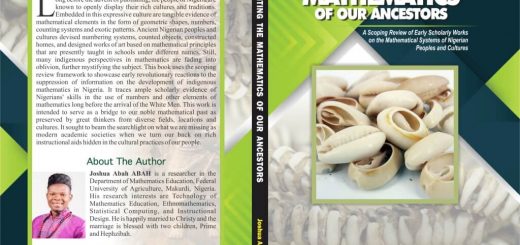The Twelve Days of Christmas
![]()
Christmas will soon be here! Being the biggest holiday season in the country, many activities of families, basic schools and churches are being re-designed around Christmas, establishing a new social pattern for many literate homes. Apart from the traditional presentation of new clothing materials like shoes, cloths, sunshades, Santa-toned caps and badges to children, parents and guardians are beginning to see the  need to encourage their wards to participate in Christmas programmes at school, in churches and in play groups within the neighbourhood. Many basic schools now organize colourful end-of-first-term celebrations which feature the season’s Nine Lessons and Carols, presentation of Christmas-themed gifts as prizes, and dancing with “Father Christmas”. Children expectantly look forward to these events at school and there are never dull moments at the music rehearsals. One of the challenging poems children often work hard to master is the Twelve Days of Christmas. Here comes the full song!
need to encourage their wards to participate in Christmas programmes at school, in churches and in play groups within the neighbourhood. Many basic schools now organize colourful end-of-first-term celebrations which feature the season’s Nine Lessons and Carols, presentation of Christmas-themed gifts as prizes, and dancing with “Father Christmas”. Children expectantly look forward to these events at school and there are never dull moments at the music rehearsals. One of the challenging poems children often work hard to master is the Twelve Days of Christmas. Here comes the full song!
 On the first day of Christmas,
On the first day of Christmas,
My true love sent to me
A partridge in a pear tree
On the second day of Christmas
My true love sent to me
Two turtle doves
And a partridge in a pear tree
On the third day of Christmas
My true love sent to me
Three French hens
Two turtle doves
And a partridge in a pear tree
On the fourth day of Christmas,
My true love sent to me
Four calling birds,
Three French hens
Two turtle doves
And a partridge in a pear tree
On the fifth day of Christmas
My true love sent to me
Five golden rings
Four calling birds
Three French hens
Two turtle doves
And a partridge in a pear tree
On the sixth day of Christmas,
My true love sent to me
Six geese a-laying
Five golden rings
Four calling birds
Three French hens
Two turtle doves
And a partridge in a pear tree
On the seventh day of Christmas,
My true love sent to me
Seven swans a-swimming
Six geese a –laying
Five golden rings
Four calling birds,
Three French hens
Two turtle doves
And a partridge in a pear tree
On the eight day of Christmas,
My true love sent to me
Eight maids a-milking,
Seven swans a-swimming
Six geese a-laying
Five golden rings
Four calling birds,
Three French hens
Two turtle doves
And a partridge in a pear tree
On the ninth day of Christmas,
My true love sent to me
Nine ladies dancing
Eight maids a-milking
Seven swans a-swimming
Six geese a laying
Five golden rings
Four calling birds
Three French hens
Two turtle doves
And a partridge in a pear tree
On the tenth day of Christmas
My true love sent to me
Ten lords a-leaping
Nine ladies dancing
Eight maids a-milking
Seven swans a-swimming
Six geese a-laying
Five golden rings
Four calling birds
Three French hens
Two turtle doves
And a partridge in a peer tree
On the eleventh day of Christmas
My true love sent to me,
Eleven pipers piping,
Ten lords a-leaping
Nine ladies dancing
Eight maids a-milking
Seven Swans a-swimming
Six geese a-laying
Five golden rings
Four calling birds
Three French hens
Two turtle doves
And a partridge in a pear tree
On the twelfth day of Christmas
My true love sent to me,
Twelve drummers drumming
Eleven pipers piping,
Ten lords a-leaping
Nine ladies dancing
Eight maids a-milking
Seven Swans a-swimming
Six geese a-laying
Five golden rings
Four calling birds
Three French hens
Two turtle doves
And a partridge in a pear tree
The Mathematics in the Song
The poetry of Twelve Days of Christmas reveals the singer receives the gift of a partridge in a pear tree on one day, two turtle doves and a partridge in a peer tree on the second, three French hens, two turtle doves …, which at any rate mounts to a lot of stuff by the twelfth day[1]. So, the first mathematics that comes to mind from the song is in the question: how many gifts? The easiest, though longest, method to calculate the total is to simply add them up.
Table 1: Adding up the gifts in Twelfth Days of Christmas
| Day of Song | Number or Gifts |
| One | 1 + |
| Two | (1+2) + |
| Three | (1+2+3)+ |
| Four | (1+2+3+4)+ |
| Five | (1+2+3+4+5)+ |
| Six | (1+2+3+4+5+6)+ |
| Seven | (1+2+3+4+5+6+7)+ |
| Eight | (1+2+3+4+5+6+7+8)+ |
| Nine | (1+2+3+4+5+6+7+8+9)+ |
| Ten | (1+2+3+4+5+6+7+8+9+10)+ |
| Eleven | (1+2+3+4+5+6+7+8+9+10+11)+ |
| Twelve | (1+2+3+4+5+6+7+8+9+10+11+12) = |
| Total | 364 |
Spice[1] observes that the totals for each day, i.e., 1, 3, 6, 10, etc are what the ancient Greeks called “triangular numbers”, because they can be arranged in a compact triangular pattern. Triangular numbers have a number of interesting properties. In the case of calculating gifts in Twelve Days of Christmas, they can shorten the work. It is easy to see how many gifts are given on each day simply by scanning down the sequence of triangular numbers. The 10th triangular number (i.e. in the sequence) for instance, is 55, so one immediately knows that 55 gifts were given on the 10th Day. To get a total for the entire 12 Days, the student just need to add up the first 12 triangular numbers.
The Mathematics and the Environment[2] research team at University of Exeter’s Penryn Campus in Cornwall took the analysis of the mathematics in Twelve Days of Christmas a bit further by finding a formula for the number of presents for N days of Christmas. According to the computations suitable for undergraduates taking Mathematical Analysis course, the number of presents on each n-th day of Christmas is equal to the sum of the first n integers.
Further classroom math activities derivable from this amazing poem can be found in the full work here[3]. Click on Resources (Audio) to download the full song.
Educational Implication of Twelve Days of Christmas
Augmenting routine classroom instruction with relevant and related mathematical facts raises the aesthetic value of the subject. The target of this style of mathematics instruction is to stimulate curiosity and sustain interests in students, while enriching the repertoire of the mathematics teachers by enriching their pedagogical content knowledge[4]. When poetry-based materials are employed to persuade students to think about instructional content in mathematics, they will be more capable of applying and extending what they learned to new situations, with the instructor facilitating both understanding and integration of subject matter[5]. Such alternative discourse in which learners could explore mathematical ideas strengthens students’ cognitive understanding of mathematical concepts and simultaneously bolsters students’ confidence in carrying out mathematical operations.
Poems and songs such as the Twelve Days of Christmas when deployed in instructional context allow group and individual learning, team building, reinforce teaching concepts, and expose students of all ages to singing. Additionally, mathematical lyrics aid recall, reinforce mathematical thinking processes, connect to history, connect to the real world and humanize mathematics[6]. Lesson from the use of the carol in the classroom may spur an innovative basic school into organizing mathematics poetry competitions.
In catering for students who are not deemed kinaesthetic, an opportunity could be created where students are allowed to express themselves in poetic form. In this type of competition, students will write poems to reflect different mathematical concepts. The best poem will be identified according to how much it embodies a particular mathematical concept as well as creativity. Poems could be written at the end of a topic. The writer of the best poem could be given prizes or highlighted on the school’s notice board[7].
The Twelve Days of Christmas can be used at the Upper Basic education level in Nigeria to create extra challenges for students. Group activities in which students can create a page of a catalogue, advertising each present and be asked how they would persuade people to buy them can also be introduced[8]. Students can be made to re-write their own versions of the song with more modern presents and provide an accompanying price list.
For students taking advance courses in computer science, the pattern revealed in Twelve Days of Christmas holds further significance. The carol fall into a class of folk songs and holiday songs in which each verse consists of the previous verse, with one extra line added on. The song tends to last a long time, despite having relatively short scripts. According to Kleinberg and Tardos[9] one can convey the words plus instructions for the song by specifying just the new line that is added to each verse without having to write all the previous line each time. This asymptotic property can be deployed in algorithm development to encode such a song using a script that has length f(n) which grows as slowly as possible and runs for n words total[9].
Furthermore, Abah[4] recommends that mathematics educators in particular and teachers in general consider the epistemological and cultural approach in the design and delivery of instruction. Introducing ideas from a wide cultural background into classroom teaching, as emphasized for the Twelve Days of Christmas, not only demystify the abstract concepts, but foster a sense of admiration of past contributors to knowledge and build openness and global intellectual relationship in learners. The visual and musical appeal of the Christmas carol lend it as tools for aiding the teaching of students known to have mathematics learning difficulty.
Evidently, only a high level of co-ordination on the part of the mathematics teacher can prevent mathematics instruction from being reduced to mere data transmission, a process in which there is no sharing of excitement and wonder[10]. The teacher of mathematics is expected to first develop himself or herself at the personal level in the art of building openness and honest intellectual relationships with students by leveraging on the connecting power of rudimentary mathematical artefact like the Twelve Days of Christmas in instruction delivery. Abah[10] emphasizes that every mathematics class should be loaded with rich learning experiences based on the teacher’s ability to connect the past to the present and reorganize information without prejudice to distance from the current era. The Twelve Days of Christmas offers such a loaded opportunity to the innovative mathematics teacher, be it at the basic, secondary or tertiary education levels.
References
- Spice, B. (2003). On the first day of Christmas my true love gave to me … Inside Science Post-Gazette. Retrieved from http://old.post-gazette.com/downloads/20031222_12daysxmasmath.pdf
- Mathematics and the Environment (2013). Solutions for the December 2013 Newsletter puzzles. Retrieved from http://emps.exeter.ac.uk/mathematics/undergraduate/degrees/environment
- Abah, J. A. (2018). A mathematical portrayal of a Christmas carol for Nigerian basic education: The mathematics in the twelve days of Christmas. Indian Journal of Arts, 8, 43-57. A publication of The Discovery Scientific Society. Retrieved from http://www.discoveryjournals.org/arts/current_issue/2018/A4.pdf
- Abah, J. A. (2017). Viewing basic math through the lens of history: Undergraduates’ reflective learning in a history-augmented mathematics classroom. Waikato Journal of Education, 22(4), 33-48. doi:10.15663/wje.v22i4.557 . A publication of Wilf Malcolm Institute of Educational Research, The University of Waikato, New Zealand. Retrieved from http://www.wje.org.nz/index.php/WJE/article/view/557
- Glaz, S. & Liang, S. (2009). Modelling with poetry in an introductory college algebra course and beyond. Journal of Mathematics and the Arts, 3(3), 123-133.
- Lesser, L. M. (2014). Mathematical lyrics: Noteworthy endeavours in education. Journal of Mathematics and the Arts, 8, (1-2), 46-53.
- Ministry of Education (2011). Mathematics interest building handbook: Mathematics corners, clubs, competitions and games. Retrieved from http://moey.gov.jm/sites/default/files/MathInterestBuild.pdf
- Active Learning in Maths (n.d.). The twelve days of Christmas. Retrieved from https://www.activelearninginmaths.co.uk/wp-content/uploads/2017/12/XMAS-MATHS-12-day.pdf
- Kleinberg, J. & Tardos, E. (2006). Algorithm design. Boston, MA: Pearson Education, Inc.
- Abah, J. A. (2016). Recency bias in the era of big data: The need to strengthen the status of history of mathematics in Nigerian schools. Advances in Multidisciplinary Research Journal, 2(4), 241-248. A Publication of the International Centre for Information Technology & Development, Southern University, Baton Rouge, LA, USA. Retrieved from http://media.wix.com/ugd/185b0a_9b1253273fea46768d1d96dcd03f4887.pdf
Views: 1659















